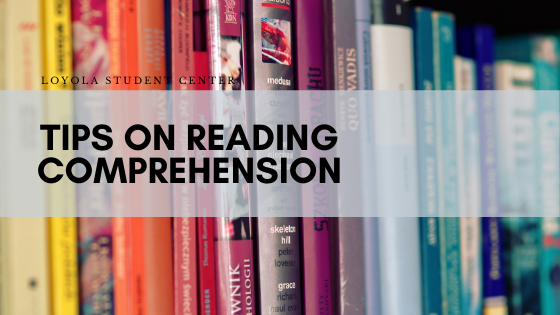Reading Comprehension Tests are composed of selections which are varied in length and in difficulty. The questions framed in these tests seek to determine the student’s ability to:
- identify the central thought or the main idea of a passage or selection
- find supporting details mentioned in the passage or selection
- draw inferences or implications from the passage or selection
- determine the meanings of words which may be unfamiliar through context clues
- know the mood, style, or purpose of the writer
Identifying the Central Thought/Main Idea
The central thought or the main idea is what the whole passage or selection is about. This is stated in the topic sentence which may be found anywhere in the paragraph, although it is usually located in the opening or closing sentences. Questions testing the reader’s ability to find the central thought or the main idea may be framed in different ways. The following are some of the most common forms:
- The main idea of the selection may best be expressed as…
- This passage illustrates…
- The title which best expresses the ideas of the passage is…
- Which of the following best expresses the theme of the passage?


Finding Supporting Details
A writer will make statements to expound on the central thought or the main idea of the paragraph or passage. The following questions are some of the most common ones framed regarding the statements made by the writer/author in the development of the paragraph or passage:
- The author states that…
- All of the following are mentioned in the paragraph except…
- In paragraph ______, it was stated that…
- Which of the following is correct?
Drawing Inferences or Implications
Some questions test the reader’s ability to understand the text and read between the lines. In these questions, it is not enough that the reader takes note of the details mentioned. He should also be able to note the logical development of the author’s statements in order to reason intelligently. Questions may be framed as follows:
- Based on the selection, it can be said that…
- The author implies that…
- All of the following may be true except…
- Which do you think…?


Determining the Meanings of Unfamiliar Words through Context Clues
Reading examination questions sometimes test the reader’s ability to determine the correct meanings of words mentioned in the selection. These words may be either common or unfamiliar. If the word is a common one, the reader must determine its meaning based on how it is used in the sentence. However, if the word is unfamiliar, the best thing that could be done is to determine its meaning through a careful examination of the text. The following are some of the ways in which the questions on vocabulary may be formed:
- In the passage, the word “______” means…
- In paragraph ______, the word “______” may mean all the following except…
- Based on the text, which of the following is the best meaning of the word “______”?
Knowing the Mood, Style or Purpose of the Writer
It is also important for the reader to know the writer’s attitude, emotional state, or point of view in the course of his understanding of the development of a paragraph or essay. Likewise, knowledge of the writer’s style and purpose in writing may also help enable the reader to fully comprehend the given text. Questions to determine the mood, style, or purpose of the writer may be expressed in the following forms:
- The author’s attitude toward ______ is one of …
- The author wrote the essay with the purpose of…
- The author used the technique of…
- What style did the author make us of to emphasize the main idea?
- How was the paragraph developed?

